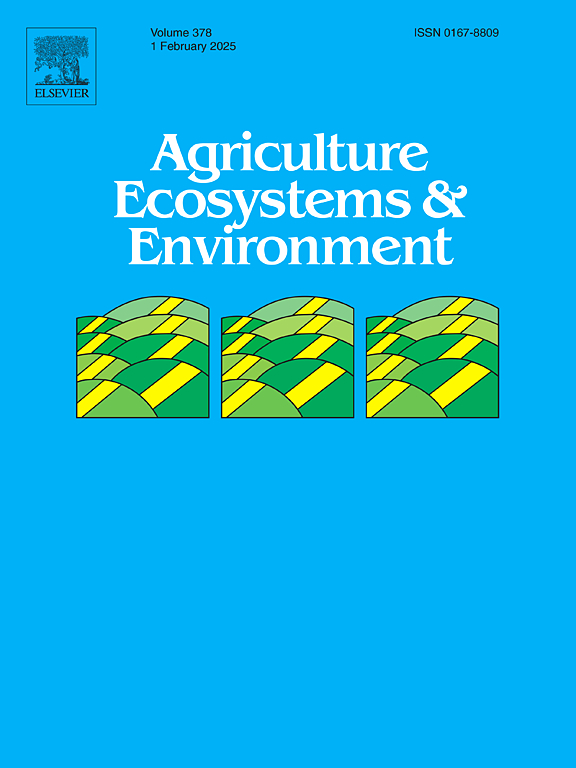Unraveling microclimate effects on pollinator foraging and crop yield in lowbush blueberry
IF 6
1区 农林科学
Q1 AGRICULTURE, MULTIDISCIPLINARY
引用次数: 0
Abstract
Pollination services are critical for many nutrient dense and high-value crops worldwide. However, pollinator foraging is not distributed evenly across space potentially contributing to crop yield variability. Here we evaluate how microclimate as well as distance from forest edge and managed honey bee hives influence fine-scale foraging by both wild and honey bees and correlate to lowbush blueberry yields. Topographic variation resulted in microclimates with differences of as much as 10 °C and 29 % relative humidity. Honey bees were the predominant visitors and were correlated with wild bee visitation which did not vary with distance from honey bee hives. Both groups had substantial temporal and microclimatic overlap in their foraging profiles, though wild bees foraged earlier and at a wider range of conditions. The positive effect of warmer microclimates on wild bee foraging was similar in magnitude to the negative effect of forest edge distance. Flower density, which was greater in sites with warmer microclimates, was the primary driver of foraging for both wild bees and honey bees as well as yields. After accounting for flower density, no relationship was observed between either wild or honey bee visitation rates and blueberry yields, suggesting that pollination services were not limiting yield. Our findings indicate that microclimates within fields can have stronger effects on crop yield than other well recognized factors, mediated by their effects on floral density and bee foraging. Given higher microclimatic variability at higher temperatures, our findings suggest an avenue by which climate change may impact within-field yield variability.
揭示小气候对低灌丛蓝莓传粉昆虫觅食和作物产量的影响
授粉服务对世界上许多营养密集和高价值作物至关重要。然而,传粉媒介的觅食并不均匀地分布在整个空间中,这可能会导致作物产量的变化。在这里,我们评估了小气候以及与森林边缘的距离和管理的蜂巢如何影响野生蜜蜂和蜜蜂的精细觅食,并与低丛蓝莓产量相关。地形变化导致小气候的差异高达10 °C和29 %的相对湿度。蜜蜂是主要的访蜂群,与野生蜜蜂的访蜂群相关,且访蜂群与蜂巢的距离无关。尽管野生蜜蜂觅食的时间更早,条件范围更广,但这两个群体在觅食剖面上都有大量的时间和小气候重叠。温暖的小气候对野生蜜蜂觅食的积极影响与森林边缘距离的消极影响在程度上相似。在温暖的小气候地区,花的密度更大,这是野生蜜蜂和蜜蜂觅食以及产量的主要驱动因素。考虑到花的密度,野生或蜜蜂的访问率与蓝莓产量之间没有关系,这表明授粉服务并没有限制产量。我们的研究结果表明,田间小气候对作物产量的影响比其他已知因素更大,其介导因素是对花密度和蜜蜂觅食的影响。鉴于较高温度下较高的小气候变异性,我们的研究结果提出了气候变化可能影响田间产量变异性的途径。
本文章由计算机程序翻译,如有差异,请以英文原文为准。
求助全文
约1分钟内获得全文
求助全文
来源期刊

Agriculture, Ecosystems & Environment
环境科学-环境科学
CiteScore
11.70
自引率
9.10%
发文量
392
审稿时长
26 days
期刊介绍:
Agriculture, Ecosystems and Environment publishes scientific articles dealing with the interface between agroecosystems and the natural environment, specifically how agriculture influences the environment and how changes in that environment impact agroecosystems. Preference is given to papers from experimental and observational research at the field, system or landscape level, from studies that enhance our understanding of processes using data-based biophysical modelling, and papers that bridge scientific disciplines and integrate knowledge. All papers should be placed in an international or wide comparative context.
 求助内容:
求助内容: 应助结果提醒方式:
应助结果提醒方式:


